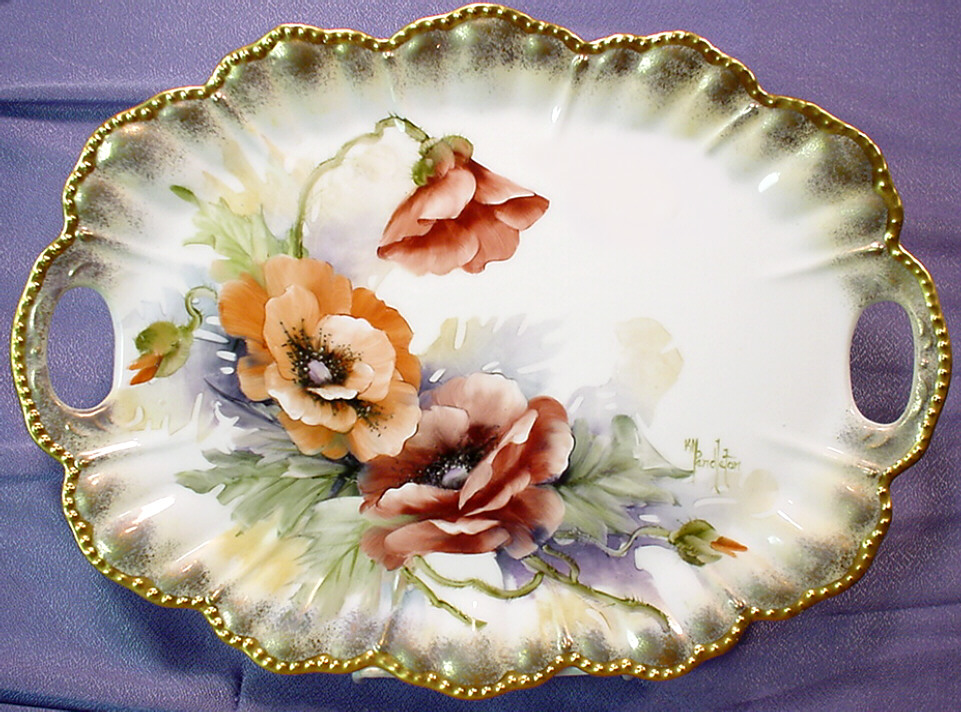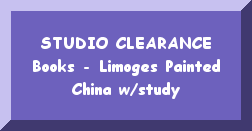 | ||||
Karla Pendleton
Karla's Favorite Links
My love of china painting is rooted in the teaching of my mother, Betty Humphrey. It is our goal to share this unique and wonderful art form with as many people as possible and to challenge porcelain artists to new levels of achievement. In pursuit of this goal my husband, Steve, and I present various educational activities as we travel. Activities are scheduled according to previous travel commitments on a first come, first served basis. Described below are teaching fees, activity descriptions, and a general supply list which you may find informative. A $150 non-refundable deposit is required before dates can be reserved for your group. I teach many different floral subjects: pansies, violets, double violets, iris, sweet peas, clematis and wild roses are a few of my personal favorites, but you are by no means limited to these. I'm probably best know for my one fire technique. However, we are not necessarily limited to this technique. I'm also very well acquainted with more traditional methods. If you are interested in sponsoring an educational activity for your organization please contact me at:
PO Box 665, Silverton, CO, 81433 USA
Phone: 970-387-5138
Email: khpendleton@hotmail.com
Workshops: include 2 - 5 days of group instruction working toward the completion of 1 or more pieces. Limited individual attention, Karla does NOT correct student work. Usual hours 9AM - 5PM with 45 min. for lunch.
Paint-Alongs: include up to 6 hours of in-class demonstrations as students paint along. No individual attention, class instructions only.
Demonstrations: include 1 - 2 hours of technique demonstration only, with questions and answers. No students will be painting.
I reserve the right to display and sell products during all activities.
Activity Descriptions
Teaching Fees
Workshops: $200.00/day (30 students max.)
Paint-Alongs: $150.00/day (no student limit) Demonstrations: $75.00 (1 - 2 hour demo) Private Instruction: $120.00/6 hours of private instruction in my studio
Transport and Lodging Fees
 | ||||
If hospitality is not available we will need to charge back to the organization any lodging fees incurred during our stay as well as transportation expense. Please contact us to determine these expenses for your group.
 | ||||
China (contact me for recommendations)
Mixed paints and palette
Open painting medium (no mineral oil)
Small dish with approx. 1/4" lip for medium
Brushes (3/4" & 1/2" sq shaders & long liners)
Brush cleaner and container
Paper towels, blotting cloth, etc.
Any other supplies which you like to use
Once a subject is selected Karla will send a
detailed supply list to workshop coordinator
General Supply List
Karla Pendleton's Art Education Information
Art-Aide Mixing and Painting Medium - Instructions
General Description
Betty Humphrey's Art-Aide is a superior general purpose medium used for mixing china paints (overglazes) as well as brush loading for painting on porcelain and glass surfaces. Art-Aide is an open (non-drying) medium which was originally developed for meeting the needs of one-fire artists. It is also an excellent multiple-fire medium due to its ability to hold color without chipping and run resistance during firing. Porcelain artists will find that this medium produces particularly brilliant colors and will resist fading. Art-Aide can also be used as a non-drying pen oil.
Application Instructions
My one-fire method requires a wet brush combined with a heavy application of paint. For better color retention, mix your paints with Art-Aide. Paint application should be such that the painted surface "glistens", but is not puddled or soupy looking. Also avoid heavy build-ups of dry paint which can cause chipping. I normally load my brush with medium, wiping the excess against the lip of my medium dish and going directly into the paint - do not blot before loading with paint. For multiple-fires and "washes" you may use a drier brush for paint application - light blotting is OK.
Mixing Raised Paste and Enamel
Add Art-Aide to raised paste or enamel and mix until "crumbly" (like pie dough). Thin with turpentine (no substitutes) until reaching the right consistency for brush work or stringing. Turpentine supplies the fat oil which is needed to keep the paste and enamel from flattening when fired. If you are planning to apply enamel over wet paint, DO NOT thin with turpentine, but continue adding Art-Aide until the correct consistency is reached. The enamel will flatten more, but will still provide relief. Turpentine in the enamel will leave a "halo" wherever it touches the wet paint, which may not be noticed until after firing. Colored enamels may be mixed using paint from your palette which has been mixed with Art-Aide, combined with white enamel.
Mixing Flux for Incising or Incising Powders
Mix Art-Aide with flux or incising powder until the consistency of heavy cream and apply with a brush to the area to be incised. Sprinkle the incising beads over this area, clean up loose beads and fire at 014. Cool kiln rapidly then chip off incised glaze.
Address: PO Box 665, Silverton, CO 81433, USA
Phone: (970)387-5138 OR (970)799-1788
Email: khpendleton@hotmail.com
Barbara Ramsey-Snow's Background Oil
General Description
Barbara Ramsey-Snow's Background Oil takes the work out of laying down a superb, shiny, solid ground using standard china paints. Coverage varies with color chosen. Dark browns, blacks, dark greens, iron-based oranges, reds, violet work best, often obtaining complete coverage in only 2 fires without chipping. Colors which may require 3 or more coats are the blues, rubies, purples and pinks.
Grounding Instructions
Use Background Oil for mixing and painting. Mix dry china paint with Background Oil to the consistency of regular china paint. Apply first coat with a brush using Background Oil as the medium. This coat does not need to be padded or consistently solid. Just brush paint on quickly and as smoothly as you can, it dries rapidly. Fire at minimum of 016. Apply a second coat (if paint is dry don't try to reconstitute, mix fresh). You should see and feel the first coat of fired paint grab and hold this next coat. Fire again at 016. Repeat the process, if necessary, until you have the coverage you want.
Texturing Instructions
Mask areas which are not to be textured with red resist. Mix paint as above and use a brush to apply a heavy coat of paint on area to be textured. Use an eyedropper to drip dispersing agent onto surface of wet paint. Let gravity take over to run paint down the sides or rotate and tip the piece to create a marbleized effect. Let dry and remove resist. Fire at a minimum of 016.
Helpful Hints
Laying on paint too heavily or too dry can result in chipping (paint should be mixed to the consistency of cold honey). Painting too wet can cause runs (surface of paint should glisten and appear wet but not be puddled or oily looking). Ground last, after you have finished painting your design, too many fires can cause the surface to appear "smoky". You can fire your gold work after finishing the grounding, but keep fires of the grounded area to a minimum.
Site last updated on: 2/23/2024
Success with Lusters
Lusters (including gold, white gold, palladium, platinum) are very sensitive to contamination, keep them away from turpentine, brush cleaners, and other oils. When I’m doing luster work I put away my china paints and brushes. Use luster/gold essence to thin lusters, use small amounts of clove oil to keep lusters open longer. Avoid cross contamination of lusters by using a separate brush for each luster color family (blues, gold, pinks, orange, halo, etc.). Lusters are very unpredictable in combination. Be sure to test fire combinations before doing serious work. White for Pastels luster will combine with other lusters to produce a pastel version of the color.
I prefer 100% acetone for cleaning brushes, smears, etc. Denatured alcohol is often recommended, but usually contains water which will mar luster. Isopropyl alcohol contains oil which will mar luster also. To apply a smooth coat of luster, use a fine cosmetic sponge loaded with the appropriate color. After luster is applied pounce lightly with a clean sponge until surface is smooth. Fire then apply a second coat using the same process. Continue applying coats firing in between until the proper depth of color has been achieved. A smoother surface will be obtained with multiple thin coats rather than 1 heavy coat. If luster is applied too heavily it can turn cloudy and/or powdery. Avoid application on very humid days which can cause spotting. Also avoid sneezing/coughing on luster.
Lusters can be applied with a technique called “dipping”. Dipping involves, floating small drops of luster on top of a large-mouthed jar filled with water. A small piece of china that fits in the mouth of the jar is randomly dipped into the luster as it floats on the water, creating interesting patterns on the china. Continue the process until the luster patterns are pleasing.
I fire all of my lusters including gold at 016. I do a graduated fire (low, medium, high) and vent the top of the kiln by leaving the lid slightly (1/8”) open and the plug out. Lusters need plenty of oxygen. I have never experienced a problem with firing lusters and china paint together.
Interesting textures can be formed when a luster (for example, Warm Silver Gray) is applied smoothly with a sponge and fired. Layer a dark luster (for example, Deep Blue) on top of the first luster. Apply with a sponge. Use an eye dropper to “drip” acetone, or essence into the wet luster, bringing out the bottom fired luster color. When a pleasing texture is obtained, fire. Several layers and colors can be applied in this manner. Interesting patterns can also be formed by “spritzing” the acetone, or luster using a fine spray bottle.
Karla Pendleton’s Textured Structure Powder
Uses:
Provides raised, rough, “nuggety” texture on glazed or unglazed porcelain or ceramic material
Provides a “base” for fusing glass onto glazed or unglazed porcelain or ceramic material
Mixing Instructions:
Shake powder in packet and “scrunch” with fingers to mix well before using. Pile an appropriate amount of Raised Texture Powder for your project onto a tile. If desired, add dry powdered paint to the Texture powder and mix thoroughly. Remember that most colors will fire darker, some may even change tone. A test fire with a small sample is helpful. When starting a project be sure to mix enough as it will be difficult to “match” colors if you run out. Texture Powder may be mixed with water or milk, but I find that these dry too quickly for most purposes. I prefer to mix it with Water-Based Medium which keeps the texture material workable for a longer period of time. Fill a small spray bottle with Karla Pendleton’s Water Based Medium, pick up an eyedropper full of medium and apply to pile of Raised Texture Powder mixture. Mix to the consistency of “gritty toothpaste”. Do not try to “grind” this mixture, it should be gritty. Apply Raised Texture with palette knife, coarse sponge, bubble wrap, air gun or whatever else your imagination can conjure up to make an interesting texture. If the mixture becomes too dry mix in more medium. Raised Texture is difficult to reconstitute if you let it dry too much. Fire to 016. Textured Structure Powder can also be mixed with an oil-based medium, slight flattening may occur.
Applying Glass For Fusing:
Use long tweezers or other grabbing instrument to pick up and apply glass chips and/or glass beads. Build up a slight mound of Raised Texture Powder to secure glass to surface of porcelain or ceramic. There are different types of glass for different temperatures (cold or hot work). If you’re not certain of the glass you’re using, be sure to test fire a small sample first. Some stained glass will change colors when exposed to high temperatures. Other glass resists high temperatures and will not melt properly. Taking the time to test fire now can save a world of regret later. Fire most glass to 016.
Applying Lusters and/or Gold:
Apply lusters or liquid bright gold over fired Raised Texture using a brush or sponge. A coarse sponge loaded with liquid bright gold or bright white gold lightly pounced over fired texture gives a lovely effect. Fire to recommended temperature of the luster or gold. Avoid using gold which must be burnished.
Continuing a family tradition of the finest in china painting
Art work -- Handpainted Gifts -- Supplies -- Instruction
Faux Malachite and Marbleizing Instructions
Malachite most often appears as swirls of various shades of green. However, a "malachite" look can be used with many differenent colors. A "marbled" look is more abstract and has a "sharp angled" appearance as opposed to the malachite's swirled patterns. First fire is the same whether executing the faux marble or the faux malachite.
Mix Imperial Jade and Mallard Shadow separately with mixing medium (I use Betty Humphrey' Art-Aide). Apply Imperial Jade haphazardly using a square shader and executing some short and some long strokes. Next apply Mallard Shadow in the same manner next to or nearby the Imperial Jade, not all white areas must be covered. Using a well conditioned (oiled) brush which has been lightly loaded with Imperial Jade, smooth and filter over the area. Don't overdo this step or the integrity of your colors will be lost. After smoothing you should have patches of two distinct colors which establishs your "base colors". Fire to cone 014 or hotter. I prefer cone 012-010.
Mix Nouveau Shadow and Black Green separately with mixing medium (again I use Betty Humphrey's Art-Aide). Apply Nouveau Shadow over the fired "base colors" in the same haphazard manner as before. Next apply the Black Green haphazardly. Lightly load a well conditioned brush with Nouveau Shadow and smooth over the area. Again be sure not to over do this step and lose the integrity of your color. At this point you should see none of the fired color showing through your unfired paint. Again you should have a "patch work" of Nouveau Shadow and Black Green.
FOR MALACHITE: Using a clean, synthetic comb or fan brush conditioned with brush cleaner and blotted (see note below) - wipe out the swirled patterns of the malachite look. Clean the brush often and be sure to blot before touching the surface of the paint. Drag lines through the paint using a circular motion to expose the "base colors" until you like the effect. Be sure to avoid wiping off all of your darker top colors. Fire to cone 014 or hotter. I prefer cone 012-010.
FOR MARBLE: Crumple saran wrap tightly and then "re-flatten". You should be able to see patterns formed in the saran wrap. Lay the plastic wrap over the unfired paint pressing it down lightly with your fingers. Try to move the wrap as little as possible. Now carefully remove the plastic wrap. If the appearance is unsatisfactory crumple the saran wrap into a ball and use it to lightly tap the surfaces which are not exposing enough of the "base colors". You may need to crumple and recrumple to expose fresh plastic wrap and create more random patterns until you like the effect. Fire to cone 014 or hotter. I prefer cone 012-010.
* Note: Some brush cleaners promote spreading or "haloing" of the paint. I prefer to use Durotine because this problem is minimized. However, it is important to use a well blotted brush regardless of which brush cleaner you use before touching the brush to the unfired surface.
Ramblin' Thru Roses, by Betty Humphrey is a lovely workbook with 4 four-color separation prints and all the line drawings and instructions to go with them (40 pages in all). Includes 3 color worksheets with transparencies so you can practice the strokes right in the book. See photos below. Covers are blemished.
Original price..$21.95....Now only $10ea plus shipping. We can get up to 4 copies in a flat rate priority envelope for $10.95 shipping (US ONLY - international customers contact khpendleton@hotmail.com for shipping rates). At these prices you can order several as gifts for your china painting friends or for your club. I learned to paint roses from this book many years ago.
Karla Pendleton's Grounding Oil Instructions
General Description: Grounding Oil is a flexible grounding medium which allows use with either wet or dry china paint. Wet grounding can be accomplished in one to three fires depending upon the color chosen.
Wet Grounding Instructions: Mix dry china paint with Grounding Oil to the consistency of cold honey. Apply first coat with a brush using Grounding Oil to condition the brush. This coat does not need to be padded or consistently solid. Just brush paint on quickly and as smoothly as you can, it dries rapidly. Fire at minimum of 016. Apply a second coat (if paint is dry don’t try to reconstitute, mix fresh). You should see and feel the first coat of fired paint grab and hold the second. Fire again at 016. Repeat the process, until desired coverage is reached. I'm consistently able to use Wilma Manhardt's Deep Shiny Black to cover in one coat.
Dry Grounding Instructions: Brush on a coat of Grounding Oil, then pounce using a cotton ball wrapped in silk and secured with a tie wrap. Pounce until you hear a "smacking" sound. Don't over pounce or the oil will become too thin and dry. It needs to be smooth and tacky to adhere the dry paint properly. Sprinkle dry china paint over the entire surface to be grounded. Use a dry (no oil) mop brush to remove excess paint using a piece of newspaper to catch paint, then funnel it back into the container for later use. Paint should be smooth with no excess laying on top of the grounded surface. Fire at a minimum of 016. If you have thin places ground them again and refire. Usually thin places in the paint are a result of over pouncing.
Suggestions: Grounding too heavy or too dry can result in chipping. Wet grounding with too much oil can cause runs (surface of paint should glisten and appear wet but not puddle). Dry grounding can be used to accomplish the sgraffito technique (scratch off) while the grounding oil is still open but very difficult after the grounding oil has completely dried.
 | ||||
General Description: Durotine is a hypo-allergenic, completely odorless turpentine substitute which not only clean your brush but conditions it as well. Simply clean the brush in Durotine and put it away when finished painting. There is no need to "oil" it before storage. This cleaner will not stiffen brushes.
"Salvaging" a stiff brush: Soak the brush hairs in a 50/50 mixture of lavendar oil (imitation is fine) and and adhesive remover like Goo-Gone (or any other citrus based cleaner). Swish and press against the side of the container until you start to see the "gunk" coming out of the brush. Continue swishing and pressing until no more gunk is coming out. For stubborn brushes, soak overnight by suspending the brush in the lavendar oil mixture. A pencil can be placed perpendicular to the brush handle and held in place by a ruber band so that the brush hair is soaking in the mixture without touching the bottom of the container. Also avoid prolonged soaking of the ferrule as the mixture can loosen the glue binding the brush hair to the handle. Once the brush has become soft and pliable again, you can use the Durotine for the final clean and rinse. Be aware that any medium you use that contains a lot of fat oil (most drying oil based mediums such as grounding oils) will eventually stiffen your brush again and you may need to repeat the deep cleaning.
Avoid using Turpentine as a brush cleaner: Turpentine contains fat oil which over time accumulates in a brush and stiffens it as well as damaging the hair, unless it is cleaned regularly in the lavendar oil and adhesive remover mixture. Many "drying" or "closed" mediums contain fat oil and will have the same effect on the brush. Use the 50/50 mixture immediately to clean brushed used with a medium of this type. Durotine will NOT remove this built up gunk, but it can be used to help avoid the build up in the first place.
Karla Pendleton's Durotine Brush Cleaner and Conditioner









